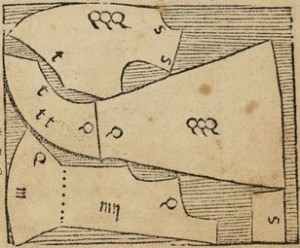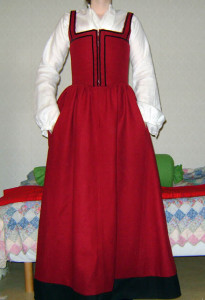I just finished transcribing and reading through the account book of William Wray, a farmer and haberdasher–dealer in fabrics and small wares–in the town of Ripon.
One of the questions responsible for beginning my research into tailors’ bills and accounts was a simple one: what did a tailor or cloth-seller make? To answer this, I had to find out how much his materials cost and how much they sold for. This opened up a whole nest of additional questions: what sort of profit did a tailor make? What about the people he bought things from? How often did a draper buy from his suppliers? Did a cloth merchant have the concept of wholesale vs retail rates? Did he sell things to different people for different amounts?
This account book has answers, or at least suggested possibilities, for several of these questions. It lists the purchases that Wray made from cloth suppliers–how many yards of what fabrics, for how much–and also records who he sold things to, and for how much. It covers the years 1588 to 1597, and contains several hundred entries.
A thorough investigation and data-crunching session will be needed to suck these accounts dry of all that they have to offer (yeah, I know, it’s on my list of things to do) but here are some of the interesting things I noticed during the transcription.
Wray bought things from a lot of people, but he bought a surprisingly narrow range of goods. The fabrics he bought–buffin, sackcloth, rash, jean fustian and milan fustian, durance–were modestly priced, affordable by the merchants and well-to-do yeomen of the town. Black and purple were the fabrics he had the most of; after that it was green, orange tawny and straw-color.
He bought from each of his regular suppliers between three to six times a year, supplementing these with the occasional purchase from others. Those one-off purchases appeared, on the whole, to cost slightly more than supplies from his regulars.
He sold lots of silk embroidery floss, fringe (black, and black-and-crimson fringe), and ribbon–everything from silk satin ribbon to lowly linen inkle tape. He also had a store of soap, starch, cinnamon, nutmeg, raisins, sugar candy and other small whatnots. He sold cheap narrow taffata (levant taffeta), gartering, and buttons of hair, silk and thread.
He bought a lot of his stock on October 11 of every year, which puzzled me until I realized that this was Michelmas day in the Elizabethan era. There must have been a festival or fair in Rippon, where various venders of fabric and small wares gathered.
He sold goods on to petty chapmen, men who traveled the roads with their wares on their back or on a wagon. He sold to the wives and men of the community, and even to a local knight, Sir Mallory.
And he made a profit of approximately 40% on the goods he bought and sold. (The buffin fabric, at least). Interestingly, Sir Mallory, Esquire, paid a third again as much for a yard of purple buffin as did another, less exalted townsman.
There’s a lot to be discovered in these accounts yet…I’ll post more conclusions as I find them.

